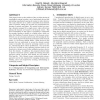60 search results - page 10 / 12 » Achieving k-Anonymity Privacy Protection Using Generalizatio... |
SP
1998
IEEE
13 years 12 months ago
1998
IEEE
A strand is a sequence of events; it represents either the execution of legitimate party in a security protocol or else a sequence of actions by a penetrator. A strand space is a ...
CCS
2007
ACM
14 years 1 months ago
2007
ACM
Virtual coordinate systems provide an accurate and efficient service that allows hosts on the Internet to determine the latency to arbitrary hosts without actively monitoring all ...
CCS
2008
ACM
13 years 9 months ago
2008
ACM
It is generally believed that by combining several diverse intrusion detectors (i.e., forming an IDS ensemble), we may achieve better performance. However, there has been very lit...
CCS
2010
ACM
13 years 7 months ago
2010
ACM
Tor, a distributed Internet anonymizing system, relies on volunteers who run dedicated relays. Other than altruism, these volunteers have no incentive to run relays, causing a lar...
ACMICEC
2008
ACM
13 years 9 months ago
2008
ACM
This paper focuses on the problem of how to allow sharing of copyrighted content between a set of authorised devices and preventing unauthoried copying of content to other devices...

